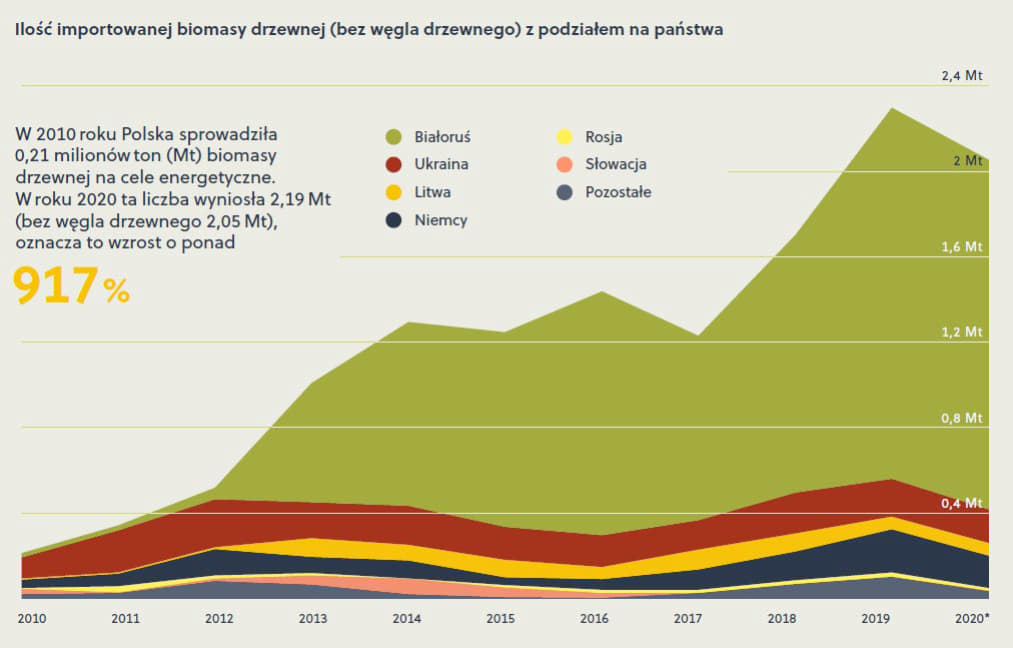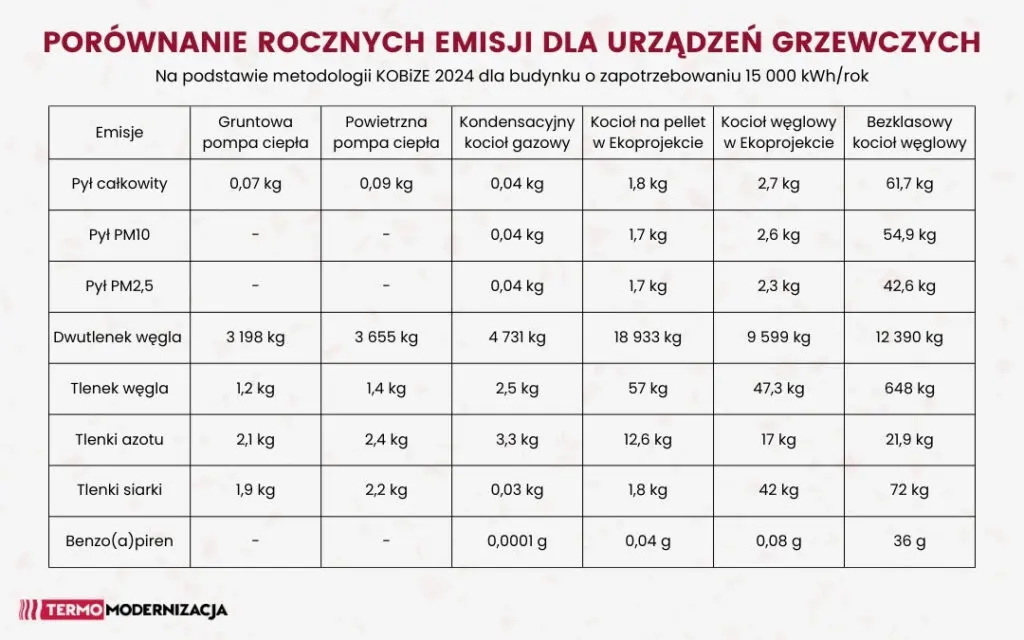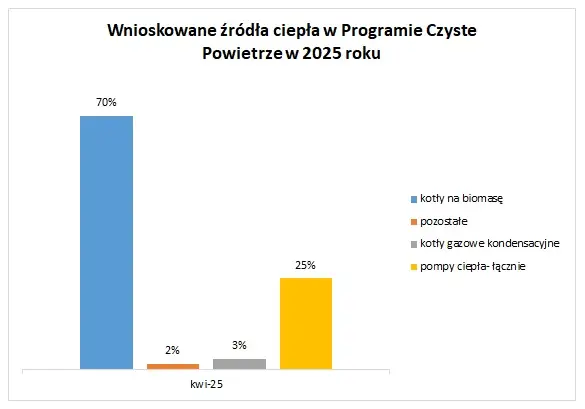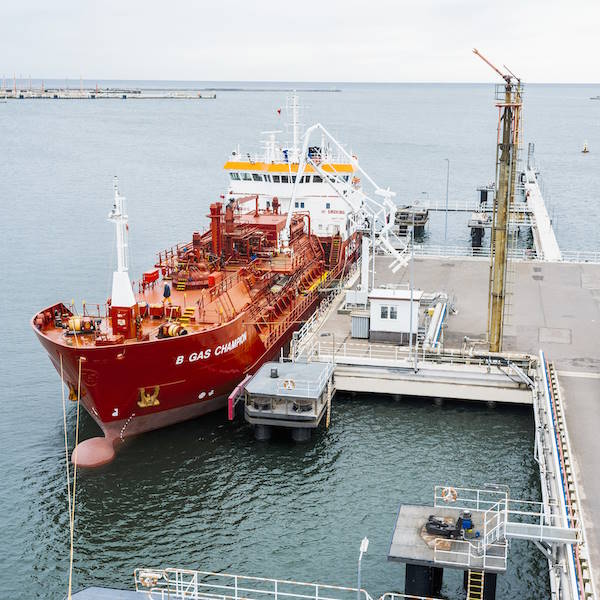Pellet Bubble in Clean Air
7.8.2025
Demand for pellet boilers has exploded, thanks in large part to preferential financing. In 2025, the share of biomass boilers in the structure of all applications for funding from the Clean Air programme is 70%. The scale of the increase in interest in pellets has eclipsed an earlier wave of interest in compressor heat pumps.
It should be noted that the issue of biomass combustion in Poland is not a new phenomenon, since 20 years ago the co-combustion of biomass with hard coal was started in Polish power plants. The key motive for the implementation of biomass co-combustion was the need to rapidly increase the share of RES in the national energy mix. Co-combustion made it possible, with relatively little investment, to start producing “green” energy, by modifying existing coal blocks so that they also burn additional biomass - including low-quality wood, waste or wood chips, as well as energy plants (energy willow, miscanthus or poplar) or broadly understood waste of plant origin: cereal straw, stalks and corn leaves, poppy seeds, sunflower husks and other by-products from field crops. By 2020, more than half of imported energy wood biomass came from Belarus, and significant quantities were also imported from Ukraine and Russia. In recent years, the directions of supply have diversified and, in addition to Russian or Belarusian, biomass imported from the Americas also reaches Poland.

Today, the same phenomenon is transferred from the level of professional power engineering to municipal heating. The unprecedented increase in the popularity of pellets is primarily associated with the excessive interpretation of the provisions of the so-called Building Directive, EPBD, and the dissemination of inaccurate information according to which, from 2025, financial support for the installation of gas boilers from public funds would be prohibited. POGP has repeatedly corrected these reports - interested We encourage you to read the July text on this subject. A huge favor for the popularization of biomass solid fuels has been done by the myth of the so-called “gas trap” popularized in 2024, which is based on the false assumption that the cost of gas fuels will increase in the next decade (in particular due to the inclusion of the heating market with the ETS2 system), while the prices of competitive fuels used for municipal heating - including biomass or electricity - will not change in the coming years.
“Clean” pellet
As a biomass fuel, pellet actually meets the renewable energy criteria set out in the Renewable Energy Directive, RED, which means that from a formal perspective its combustion can be considered CO₂ neutral.
However, this does not mean that it is a completely clean fuel. The RED Directive does not address the issue of air quality, which is regulated by another legal act - the directive... on air quality (AQD). The latter concerns, among others, the issue of emissions of particulate matter (PM10, PM2.5), nitrogen oxides or benzo (a) pyrene. Meanwhile, even modern pellet boilers, due to the type of fuel used, generate air pollution comparable to coal combustion.
According to both Polish and Italian data, the combustion of biomass - due to its chemical composition - causes higher emissions of compounds harmful to human health in the form of PM, benzopyrene, sulphur oxide (SOx) or nitric oxide (NOx) dust than in the case of natural gas and liquefied gas. According to the results of a study carried out in Italy by the InnovHub institutes Stazioni Sperimentali per Industria and Stazione Sperimentale per i Combustibili, for the two most important components of smog: dust and nitrogen oxides, emissions from the combustion of pellets per GJ are 500-2000 times higher and 5-10 times higher, respectively, than for gaseous fuels. According to a Polish analysis based on the KoBize methodology, a modern pellet-fed boiler will emit about 40 times more dust per year than a condensing gas boiler, about 4 times more nitrogen oxides and about 400 times more carcinogenic benzo (a) pyrene.
The actual carbon dioxide emissions from the combustion of biomass due to its low energy value are higher than from the combustion of coal, but from the point of view of European law - pellet boilers are considered emission-free.

findings research conducted in 2024 at the University of Silesia in Katowice demonstrate the complexity of the process of using biomass for energy purposes and demonstrate that the combustion of biomass fuels, in particular non-wood pellets, can pose a serious health risk associated with exposure to toxic emissions. Studies have proven that burning biomass pellets can lead to emissions of particulate matter, carbon monoxide, NO2, NH3, Cl2, SALT2 and HCHO above the recommended emission thresholds, especially for the combustion of non-wood pellets. The combustion of pellets from agricultural waste can pose a particular health risk associated with direct exposure to emissions. According to a study by the same team, 70% of the pellet samples analyzed did not meet the certification conditions (PL-US BIO).
In 2025, the Ministry of Climate and Environment implemented a regulation on quality requirements for biomass obtained from trees and shrubs, regulating for the first time the issue of the quality of fuel marketed as pellets. It can be hoped that in the coming years the worst quality products will therefore be eliminated from the market, contributing to reducing the environmental impact of biomass solid fuel combustion.
The pellet issue, as in a lens, presents an internal contradiction between environmental objectives and poorly designed climate protection solutions: in the name of the latter, a heating solution with a relatively high environmental impact is promoted.
Pellet bubble
In the period from September 2023 to June 2024, the percentage share of applications submitted for subsidies for biomass boilers (mainly pellets), in the total number of applications under the Clean Air programme, increased from 16% to 51%, i.e. more than 3 times. In the whole of 2024, such boilers accounted for about 48% of all applications submitted, and in 2025 the share reached 70%. The increase in the share of applications for financing biomass boilers of this level raises the question of the effectiveness of the campaign conducted for years in Poland to eliminate the problem of so-called low emissions, because the current situation is largely due to the support system, which favors biomass at the expense of other solutions.

The problem also remains the lack of an effective monitoring system for the quality of biomass entering the market. As indicated by the Department of Air Protection and Climate Negotiations of the Ministry of Climate and Environment, currently biomass - including pellets and briquettes - is not subject to systematic quality control. As a result, as the experience of research institutions shows, fuels contaminated with waste or of uncertain composition also enter the heating market. Only a part of manufacturers use quality certificates (ENplus, DINplus), and for most consumers the main criterion remains the price.
On the one hand, despite the fact that Poland has the largest number of certified pellet producers in Europe, domestic production does not cover the growing demand. In the period from 2023 to 2024, imports of biomass, pellets and wood raw materials from countries such as Ukraine, Belarus and Russia increased again. Biomass fuel is not subject to EU sanctions, which not only means that its import contributes to the financing of the Russian invasion of Ukraine, but also opens the way for the import of raw material of dubious quality. Wood from illegal logging or areas with poor environmental control goes to the market with quality certificates that only refer to the technical characteristics of the fuel and not its origin.
Unfortunately, lower pellet quality is often associated with higher emissions and operational problems. Certified fuels are more expensive, but provide better combustion parameters. Meanwhile, increasing demand — generated by support programs — leads to the phenomenon of overheating of the market, as it collides with competition for raw material from the professional energy and wood industry, including the furniture industry. In recent years, nearly 50% of wood biomass for energy production has been used by the municipal sector, and about 20% by the wood and paper industry and the power industry. The increase in the popularity of pellets in municipal heating may contribute to the formation of a price bubble.
Before the Russian invasion of Ukraine, average pellet prices in Poland oscillated at the level of 900-1100 PLN/t. The energy crisis and the outbreak of war brought a temporary shake-up of the market and price records up to 3000 PLN/t. From 2023 we are dealing with price stabilization at the level of approx. 1300-1500 PLN/t. Forecasts for the coming years indicate a continuing pressure the increase in pellet prices in Poland, created by factors such as high production costs, limited supply of raw materials and growing demand from both individual consumers and industry for friendly to the biomass of EU regulations.
It is worth noting that future pellet prices will not be burdened by the additional costs of the ETS2 system, which after 2027 will affect (to varying degrees) all hydrocarbon fuels - from gas to coal, since the combustion of biomass is treated by the European Union as emission-free.
summary
Stimulating pellet demand through support programs — including Clean Air — carries a number of systemic risks:
- ecological (import from uncontrolled sources, inability to verify the correctness of certificates of origin and quality of raw materials),
- economic (weakening of the position of domestic producers and uncontrolled increase in fuel prices due to increased demand with the introduction of quality requirements),
- in the field of energy security (increase of biomass imports from outside the European Union in place of the suspended import of Russian hydrocarbons).
Pellet boilers have their place in the heating mix and can support the decarbonization process, especially in places without access to the gas network, just like boilers powered by liquefied gas. In 2025, however, we are facing a situation of preferential treatment of biomass heating over alternative technologies that provide better environmental effects.
The quality standards for biomass solid fuels introduced in 2025 are a step in the right direction and will contribute to improving the quality of products available on the market. However, the current preferences for financing pellet boilers from public funds are in the nature of an unjustified and arbitrary favoring of this technology at the expense of others, including gas condensing boilers, whose environmental impact is lower. POGP calls for the preparation of a complementary debt financing solution that would restore consumer confidence in gas boiler technology.




